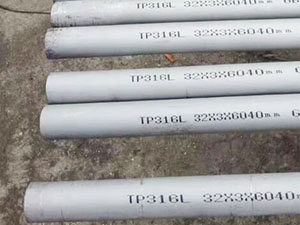Stainless 440C is a high-carbon martensitic stainless steel. As a martensitic stainless steel, 440C is magnetic and can be hardened by heat treatment. The high carbon content in 440C provides high hardness and strength. Despite this carbon content, the chromium content is sufficient to retain its stainless characteristics.
Martensitic steels are commonly used in applications where high strength and moderate corrosion resistance is required.
Chemistry
|
|
Cr
|
C
|
Mn
|
Si
|
Mo
|
P
|
S
|
Fe
|
|
MIN
|
16.0
|
.095
|
-
|
-
|
-
|
-
|
-
|
-
|
|
MAX
|
18.0
|
1.2
|
1.00
|
1.00
|
0.75
|
0.04
|
0.03
|
Balance
|
Specifications
Inventory
440C Round Bar
Features
· Attains the highest hardness of any stainless steel, when heat-treated
· Highest carbon content of 400 series stainless steels
Applications
· Valve Seats
· Surgical Instruments
· Bearings
· Bushings
· Nozzles
· Structural Aircraft Parts
Physical Properties
Density: 0.275 lb/inch3
Melting Range: 2500 - 2700°F
|
Temperature, °F
|
70
|
|
Coefficient of Thermal Expansion, in/in°F x 10-6
|
5.6
|
|
Thermal Conductivity
Btu • ft/ft2 • hr • °F
|
13.2
|
|
Modulus of Elasticity,
psi X 106
|
30.4
|
* 70°F to indicated temperature.
Mechanical Properties
Representative Tensile Properties (Hardened 1900°F, oil quench, and tempered 600°F)
|
Temperature, °F
|
70
|
|
Ultimate Tensile Strength, ksi
|
285
|
|
0.2% Yield Strength, ksi
|
275
|
|
Elongation, %
|
2
|
|
Reduction of Area, %
|
10
|
|
Hardness, Brinell
|
580
|
Typical Hardness (1" round, hardened 1900°F, oil quench, and tempered one hour)
|
Tempering Temperature, °F
|
300
|
400
|
500
|
600
|
700
|
800
|
|
Rockwell C Hardness
|
60
|
59
|
57
|
56
|
56
|
56
|
Workability
Hot Working
Preheat to 1400/1500°F, then heat slowly and uniformly to 1900/2100°F. Do not forge below 1750°F, and reheat as often as necessary. Furnace cool slowly. Anneal after forging; cool to room temperature before annealing.
Annealing
Heat to 1550 - 1600°F, slow cool in furnace. Brinell hardness should be approximately 223.
Hardening
Heat to 1850/1950°F. Quench in warm oil or air. Do not overheat. Temper between 300 - 800°F depending on desired hardness. Temper immediately after quenching.
Cold Working
If annealed for maximum softness, this steel can be moderately cold formed or headed.
Machinability
Machining is best in the annealed condition. Because of its high carbon content it machines similar to high-speed toolsteel. Chips will be tough and stringy, therefore chip curlers and breakers are important.
Grinding and Polishing
In cutlery applications, grinding and polishing are very important. Type 440C Stainless Steel works well in these operations. Do not overheat while grinding since both the hardness and corrosion resistance may be lowered.
Weldability
Because of its high-hardness capability, this steel is seldom welded. However, if welding is necessary, the parts should be preheated and maintained at about 500°F, welded, and then immediately given a 6-8 hour anneal at 1350/1400°F with a slow furnace cool. The parts should not be allowed to cool below 500°F between welding and annealing. High welding heat inputs should be used. To obtain mechanical properties in the weld similar to those in the base metal, welding consumables of like composition should be considered. Otherwise AWS E/ER309 might also be considered.





